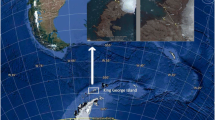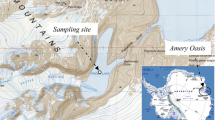Abstract
The community structure of the bacteria associated with Nodularia spumigena (Mertens) cyanobacterial aggregates in the Baltic Sea was studied with temperature gradient gel electrophoresis (TGGE), using a 16S rRNA gene fragment as a target. Various developmental stages of the aggregates and free-floating cyanobacterial filaments were sampled to reveal possible changes in associated microbial community structure during development and senescence of the aggregates. The microbial community structures of all samples differed, and the communities of young and decaying aggregates were separated by cluster analysis of the TGGE fingerprint data. Sequencing of the TGGE fragments indicated the presence of bacteria from the α-, β-, and γ-proteobacterial groups, as well as members of Cytophaga–Flexibacter–Bacteroides lineages and gram-positive Actinobacteria spp. The majority of the Nodularia-associated sequences were not closely related to previously reported 16S rDNA sequences from the Baltic Sea or any other environment. The structure of the bacterial assemblage reflects the environmental changes associated with the succession and decay of the cyanobacterial aggregates. In addition, the sequence data suggest that the N. spumigena (Mertens) blooms in the Baltic Sea may host thus far uncharacterized bacterial species.


Similar content being viewed by others
References
Acinas, SG, Antón, J, Rodríguez-Valera, F (1999) Diversity of free-living and attached bacteria in offshore Western Mediterranean waters as depicted by analysis of genes encoding 16S rRNA. Appl Environ Microbiol 65: 514–522
Altschul, SF, Gish, W, Miller, W, Meyers, EW, Lipman, DJ (1990) Basic local alignment search tool. J Mol Biol 215: 403–410
Bidle, KD, Fletcher, M (1995) Comparison of free-living and particle-associated bacterial communities in the Chesapeake Bay by stable low-molecular weight RNA analysis. Appl Environ Microbiol 61: 944–952
Braun, ST, Proctor, LM, Zani, S, Mellon, MT, Zehr, JP (1999) Molecular evidence for zooplankton-associated nitrogen-fixing anaerobes based on amplification of the nifH gene. FEMS Microb Ecol 28: 273–279
Bursa, AS (1968) Epicenoses on Nodularia spumigena Mertens in the Baltic Sea. Acta Hydrobiol 10: 267–297
Casamayor, EO, Pedrós-Alió, C, Muyzer, G, Amann, R (2002) Microheterogeneity in 16S ribosomal DNA-defined bacterial populations from a stratified planktonic environment is related to temporal changes and to ecological adaptations. Appl Environ Microbiol 68: 1706–1714
Casamayor, EO, Schäfer, H, Bañeras, L, Pedrós-Alió, C, Muyzer, G (2000) Identification and spatio-temporal differences between microbial assemblages of two neighboring sulfurous lakes: comparison by microscopy and denaturing gradient gel electrophoresis. Appl Environ Microbiol 66: 499–508
Eichner, CA, Erb, RW, Timmis, KN, Wagner-Dobler, I (1999) Thermal gradient gel electrophoresis analysis of bioprotection from pollutant shocks in the activated sludge microbial community. Appl Environ Microbiol 65: 102–109
Engström-Öst, J, Koski, M, Schmidt, K, Viitasalo, M, Jónasdóttir, SH, Kokkonen, M, Repka, S, Sivonen, K (2002) Effects of toxic cyanobacteria on a plankton assemblage: community development during decay of Nodularia spumigena. Mar Ecol Prog Ser 232: 1–14
Farrelly, V, Rainey, FA, Stackebrandt, E (1995) Effect of genome size and rrn gene copy number on PCR amplification of 16S rRNA genes from a mixture of bacterial species. Appl Environ Microbiol 61: 2798–2801
Felsenstein, J (1993) PHYLIP (Phylogeny Inference Package), version 3.5c, Department of Genetics, University of Washington, Seattle, US
Ferrari, VC, Hollibaugh, JT (1999) Distribution of microbial assemblages in the Central Arctic Ocean Basin studied by PCR/DGGE: analysis of a large data set. Hydrobiologia 401: 55–68
Glibert, PM, Bronk, DA (1994) Release of dissolved organic nitrogen by marine diazotrophic cyanobacteria, Trichodesmium spp. Appl Environ Microbiol 60: 3996–4000
Hahn, MW, Höfle, MG (2001) Grazing of protozoa and its effect on populations of aquatic bacteria. FEMS Microbiol Ecol 35:113–121
Heinänen, A, Kononen, K, Kuosa, H, Kuparinen, J, Mäkelä, K (1995) Bacterioplankton growth associated with physical front during a cyanobacterial bloom. Mar Ecol Prog Ser 116: 233–245
Hietanen, S, Moisander, P, Kuparinen, J, Tuominen, L (2002) No sign of denitrification in a Baltic Sea cyanobacterial bloom. Mar Ecol Prog Ser 242: 73–82
Hoppe, H-G (1981) Blue-green algae agglomeration in surface water: a microbiotope of high bacterial activity. Kiel Meeresforsch (Sonderh) 5: 291–303
Jackson, CR, Roden, EE, Churchill, PF (2000) Denaturing gradient gel electrophoresis can fail to separate 16S rDNA fragments with multiple base differences. Mol Biol Today 1: 49–51
Kahru, M, Horstmann, U, Rud, O (1994) Satellite detection of increased cyanobacteria in the Baltic Sea: natural fluctuation or ecosystem change? Ambio 23: 469–472
Kankaanpää, HT, Sipiä, VO, Kuparinen, J, Ott, JL, Carmichael, WW (2001) Nodularin analyses and toxicity of Nodularia spumigena (Nostocales, Cyanobacteria) waterbloom in the western Gulf of Finland, Baltic Sea, in August 1999. Phycologia 40: 268–274
Kirshtein, JD, Paerl, HW, Zehr, J (1991) Amplification, cloning, and sequencing of a nifH segment from aquatic microorganisms and natural communities. Appl Environ Microbiol 57: 2645–2650
Kisand, V, Wikner, J (2003) Limited resolution of 16S rDNA DGGE caused by melting properties and closely related DNA sequences. J Microbiol Methods 54: 183–191
Laamanen, MJ, Gugger, MF, Lehtimäki, JM, Haukka, K, Sivonen, K (2001) Diversity of toxic and nontoxic Nodularia isolates (cyanobacteria) and filaments from the Baltic Sea. Appl Environ Microbiol 67: 4638–4647
Lehtimäki, J, Lyra, C, Suomalainen, S, Sundman, P, Rouhiainen, L, Paulin, L, Salkinoja-Salonen, M, Sivonen, K (2000) Characterization of Nodularia strains, cyanobacteria from brackish waters, by genotypic and phenotypic methods. Int. J. Syst Evol Microbiol 50: 1043–1053
Lopez, I, Ruiz-Larrea, F, Cocolin, L, Orr, E, Phister, T, Marshall, M, VanderGheynst, J, Mills, DA (2003) Design and evaluation of PCR primers for analysis of bacterial populations in wine by denaturing gradient gel electrophoresis. Appl Environ Microbiol 69: 6801–6807
Maruyama, T, Kato, K, Yokoyama, A, Tanaka, T, Hiraishi, A, Park, H-D (2003) Dynamics of microcystin-degrading bacteria in mucilage of Microcystis. Microb Ecol 46: 279–288
Massana, R, Pedrós-Alió, C, Casamayor, EO, Gasol, JM (2001) Changes in marine bacterioplankton phylogenetic composition during incubations designed to measure biogeochemically significant parameters. Limnol Oceanogr 46: 1181–1188
Moisander, P, Steppe, TF, Hall, NS, Kuparinen, J, Paerl, HW (2003) Variability in nitrogen and phosphorus limitation for Baltic Sea phytoplankton during nitrogen-fixing cyanobacterial bloom. Mar Ecol Prog Ser 262: 81–95
Murray, V (1989) Improved double-stranded sequencing using the linear polymerase chain reaction. Nucleic Acids Res 17: 8889
Muyzer, G, de Vaal, EC, Uitterlinden, AG (1993) Profiling of complex microbial populations by denaturing gradient gel electrophoresis analysis of polymerase chain reaction-amplified genes coding for 16S rRNA. Appl Environ Microbiol 59: 695–700
Ohlendieck, U, Stuhr, A, Siegmund, H (2000) Nitrogen fixation by diatzotrophic cyanobacteria in the Baltic Sea and transfer of the newly fixed nitrogen to picoplankton organisms. J Mar Syst 25: 213–219
Paerl, HW (1985) Microzone formation: its role in enhancement of aquatic N2 fixation. Limnol Oceanogr 30: 1246–1252
Paerl, HW (1976) Specific associations of the bluegreen algae Anabaena and Aphanizomenon with bacteria in freshwater blooms. J Phycol 12: 431–435
Paerl, HW (1984) Transfer of N2 and CO2 fixation products from Anabaena oscillarioides to associated bacteria during inorganic carbon sufficiency and deficiency. J Phycol 20: 600–608
Paerl, HW, Bebout, BM, Prufert, LE (1989) Bacterial associations with marine Oscillatoria sp. (Trichodesmium sp.) populations: ecophysiological implications. J Phycol 25: 773–784
Paerl, HW, Millie, DF (1996) Physiological ecology of toxic aquatic cyanobacteria. Phycologia 35: 160–167
Paerl, HW, Prufert, LE (1987) Oxygen-poor microzones as potential sites of microbial N2 fixation in nitrogen-depleted aerobic marine waters. Appl Environ Microbiol 53: 1078–1087
Page, RDM (1996) TREEVIEW: an application to display phylogenetic trees on personal computers. Comput Appl Biosci 12: 357–358
Phillips, CJ, Smith, Z, Embley, TM, Prosser, JI (1999) Phylogenetic differences between particle-associated and planktonic ammonia-oxidizing bacteria of the β subdivision of the class Proteobacteria in the Northwestern Mediterranean Sea. Appl Environ Microbiol 65: 779–786
Pinhassi, J, Hagström, Å (2000) Seasonal succession in marine bacterioplankton. Aquat Microb Ecol 21: 245–256
Pinhassi, J, Zweifel, U, Hagström, Å (1997) Dominant marine bacterioplankton species found among colony-forming bacteria. Appl Environ Microbiol 63: 3359–3366
Ploug, H, Kühl, M, Buchholz-Cleven, B, Jørgensen, BB (1997) Anoxic aggregates—an ephemeral phenomenon in the pelagic environment? Aquat Microb Ecol 13: 285–294
Rashidan, KK, Bird, DF (2001) Role of predatory bacteria in the termination of cyanobacterial bloom. Microb Ecol 41: 97–105
Rice, P, Longden, I, Bleasby, A (2000) EMBOSS: The European Molecular Biology Open Software Suite. Trends Genet 16: 276–277
Salomon, PS, Janson, S, Granéli, E (2003) Molecular identification of bacteria associated with filaments of Nodularia spumigena and their effect on the cyanobacterial growth. Harmful Algae 2: 261–272
Sanger, F, Nicklen, S, Coulson, AR (1977) DNA sequencing with chain terminating inhibitors. Proc Natl Acad Sci USA 74: 5463–5467
Santegoeds, CM, Ferdelman, TG, Muyzer, G, de Beer, D (1998) Structural and functional analysis of sulfate-reducing populations in bacterial biofilms. Appl Environ Microbiol 64: 3731–3739
Sellner, KG, Olson, MM, Kononen, K (1994) Copepod grazing in a summer cyanobacteria bloom in the Gulf of Finland. Hydrobiol 292/293: 249–254
Shanks, AL, Reeder, ML (1993) Reducing microzones and sulfide production in marine snow. Mar Ecol Prog Ser 96: 43–47
Simu, K, Holmfeldt, K, Zweifel, UL, Hagström, Å (2005) Culturability and coexistence of colony-forming and single-cell marine bacterioplankton. Appl Environ Microbiol 71: 4793–4800
Stackebrandt, E, Goebel, BM (1994) Taxonomic note: a place for DNA-DNA reassociation and 16S rRNA sequence analysis in the present species definition in bacteriology. Int J Syst Bacteriol 44: 846–849
Suikkanen, S, Fistarol, GO, Granéli, E (2005) Effects of cyanobacterial allelochemicals on a natural plankton community. Mar Ecol Prog Ser 287: 1–9
Suzuki, MT (1999) Effect of protistan bacterivory on coastal bacterioplankton diversity. Aquat Microb Ecol 20: 261–272
Suzuki, MT, Giovannoni, SJ (1996) Bias caused by template annealing in the amplification of mixtures of 16S rRNA genes by PCR. Appl Environ Microbiol 62: 625–630
Tabor, S, Richardson, CC (1995) A single residue in DNA polymerases of the Escherichia coli DNA polymerase I family is critical for distinguishing between deoxy- and dideoxynucleotides. Proc Natl Acad Sci USA 92: 6339–6343
Tuomainen, JM, Hietanen, S, Kuparinen, J, Martikainen, PJ, Servomaa, K (2003) Baltic Sea cyanobacterial bloom contains denitrification and nitrification genes, but has negligible denitrification activity. FEMS Microbiol Ecol 46: 83–96
von Wintzingerode, F, Göbel, UB, Stackebrandt, E (1997) Determination of microbial diversity in environmental samples: pitfalls of PCR-based rRNA analysis. FEMS Microbiol Rev 21: 213–229
Zani, S, Mellon, MT, Collier, JL, Zehr, JP (2000) Expression of nifH Genes in Natural Microbial Assemblages in Lake George, New York, detected by reverse transcriptase PCR. Appl Environ Microbiol 66: 3119–3124
Zehr, JP, Mellon, M, Braun, S, Litaker, W, Steppe, T, Paerl, HW (1995) Diversity of heterotrophic nitrogen fixation genes in a marine cyanobacterial mat. Appl Environ Microbiol 61: 2527–2532
Acknowledgments
This study was supported by the Academy of Finland (J.T. & S.H.), the Maj and Tor Nessling Foundation (S.H.), Onni Talas and Walter and André de Nottbeck Foundations (J.T.), and EnSTe-Graduate School (J.T.). We thank the crew of the R/V Aranda for their help in sampling, and Dr. H. Kankaanpää and Dr. V. Sipiä (Finnish Institute of Marine Research) for sharing their cyanobacterial filament samples. The technical assistance of N. Partanen and T. Rahkonen is gratefully acknowledged. Ritva Vasara, MSc, and two anonymous reviewers are acknowledged for their constructive comments on the manuscript.
Author information
Authors and Affiliations
Corresponding author
Rights and permissions
About this article
Cite this article
Tuomainen, J., Hietanen, S., Kuparinen, J. et al. Community Structure of the Bacteria Associated with Nodularia sp. (Cyanobacteria) Aggregates in the Baltic Sea. Microb Ecol 52, 513–522 (2006). https://doi.org/10.1007/s00248-006-9130-0
Received:
Accepted:
Published:
Issue Date:
DOI: https://doi.org/10.1007/s00248-006-9130-0




